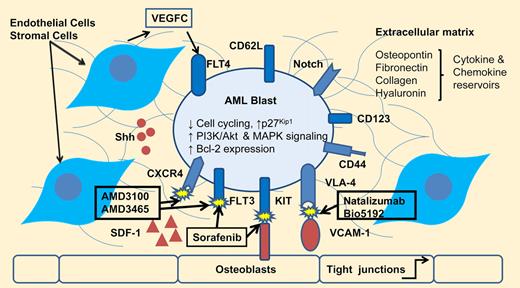In this issue of Blood, Nervi and colleagues and Zeng and colleagues independently report similar findings in both in vitro and in vivo AML models, showing chemosensitization by blocking CXCR4/CXCL12 (SDF-1α:stromal cell–derived factor 1) signaling using novel CXCR4 antagonist bicyclams, namely AMD3100 (plerixafor) and AMD3465.
CXCR4 and its ligand SDF-1/CXCL12 have been identified as key participants in many pathways including cell movement, HIV entry into permissive cells, leukemic and normal stem cell trafficking, and remodeling of marrow niches. The impact of CXCR4-SDF-1/CXCL12 signaling has recently been linked to cell survival and chemosensitization in several cancer models including breast, lung, prostate cancer, multiple myeloma and chronic lymphocytic leukemia as well.1,2 SDF-1/CXCL12 and stem cell factor / kit ligand (SCF/KL) are elaborated by marrow osteoblasts/ stromal cells and specialized endothelial cells and are essential components of hematopoietic marrow niches (see figure).3 Recently, leukemic cells were shown to suppress normal hematopoiesis by down-regulating CXCL12 within these niches while neutralization of SCF/KL improved migration of normal progenitors within these areas,4 hinting at new mechanisms of leukemia-mediated suppression of normal hematopoiesis. Similarly, granulocyte colony-stimulating factor (G-CSF)–mediated stem/progenitor cell mobilization involves secretion of proteases, attenuation of integrin adhesive function, and disruption of CXCL12/CXCR4 signaling in the marrow. The same principle applies to other mobilizing cytokines, such as FLT3 ligand and SCF, which down-regulate CXCL12 expression within the marrow, and decrease CXCR4 expression on hematopoietic progenitor cells, which underscore the central role of the CXCR4/ CXCL12 axis in mobilization processes.5 AMD3100 (plerixafor) has now received FDA approval to boost G-CSF–mediated CD34 stem cell mobilization in lymphoma and myeloma.6
Using a murine acute promyelocytic leukemia (APL) model, Nervi et al show convincingly that AMD3100 can mobilize leukemic cells from intramedullary (but not intraperitoneal) niches into the peripheral circulation and the spleen.7 They also show that stromal cells interacting with leukemic cells confer chemoresistance. The dislodgement of APL cells from their marrow microenvironment and/or the interruption of CXCR4 signaling by AMD3100 may explain the increased cell kill observed with cytarabine and anthracyclines. Stromal APL protection can be mediated by direct cell-to-cell contact as well as via soluble stromal-derived factors. These events were tracked in vivo using novel imaging techniques and provide the underpinning of a proof of concept clinical trial in which relapsed AML patients are treated with MEC plus escalating doses of plerixafor.8 While CXCR4/CXCL12 interactions are the focus of these 2 manuscripts, the dominant role of VLA-4/VCAM-1 integrin-mediated adhesion to matrix components in stem cell homing and peripheralization should not be forgotten.9 A more optimal dislodgement of leukemic cells from their niches might be attained by combining the CXCR4/CXCL12 blockade with agents that disrupt VLA-4/VCAM-1 interactions such as natalizumab (anti–VLA-4 monoclonal antibody) or Bio5192, a small peptide that also blocks VLA-4 mediated adhesion (see figure).10-12
Protective effect of marrow microenvironment. The Hematopoietic Inductive Microenvironment (HIM) niches include osteoblasts, stromal/mesenchymal cells, endothelial cells and extracellular matrix components. AML blast quiescence, proliferation and apoptosis are influenced by receptor kinases, adhesive receptors and signaling via matrix mediated/bound chemokines and cytokines. AMD3100 and AMD3465 CXCR4 antagonists +/− sorafenib or inhibitors of VLA-4/VCAM-1 interactions chemosensitize AML blasts within the HIM niches. Shh: sonic hedgehog, Notch, vascular endothelial factor and other adhesion receptors signals promote leukemic stem cell survival and expansion and can be targeted to overcome AML chemoresistance.
Protective effect of marrow microenvironment. The Hematopoietic Inductive Microenvironment (HIM) niches include osteoblasts, stromal/mesenchymal cells, endothelial cells and extracellular matrix components. AML blast quiescence, proliferation and apoptosis are influenced by receptor kinases, adhesive receptors and signaling via matrix mediated/bound chemokines and cytokines. AMD3100 and AMD3465 CXCR4 antagonists +/− sorafenib or inhibitors of VLA-4/VCAM-1 interactions chemosensitize AML blasts within the HIM niches. Shh: sonic hedgehog, Notch, vascular endothelial factor and other adhesion receptors signals promote leukemic stem cell survival and expansion and can be targeted to overcome AML chemoresistance.
Besides abnormal cytogenetics, recently recognized high-risk features in AML include FLT3-ITD/ mutations and prominent CXCR4 surface expression.13,14 In the other paper addressing leukemic niches in this, Zeng et al focus on AML cell lines as well as patient-derived AML cells and determine that the CXCR4 antagonist AMD3465 blocked signaling of the CXCL12/CXCR4 axis by suppressing stroma-activated PI3K/AKT and MEK/ERK survival pathways.15 CXCR4 inhibition partially abrogated the protection conferred by stromal cells, rendering these leukemic cells more susceptible to apoptosis when exposed to cytarabine. AMD3465 led to down-regulation of FLT3 receptor expression and inhibition of KIT signaling when used in conjunction with sorafenib, a permissive tyrosine kinase inhibitor in FLT3-ITD–expressing AML cell lines (see figure). The latter observations are very intriguing and may explain in part the successful treatment of a relapsed FLT3-ITD–positive AML patient with sorafenib in the posttransplantation setting.16
Finally, while both reports open new avenues for overcoming in vivo drug resistance in AML, it is yet unclear whether durable complete remissions can ensue from this strategy. AML is indeed a very heterogenous disease, and successful eradication of leukemic stem/progenitor cells will require blocking multiple receptors/pathways as shown in the figure, with targeted agents focused on CD44, VLA-4, CXCR4, sonic Hedgehog (shh), vascular endothelial factors VEGF, and interleukin 3 receptor alpha CD123, in addition to many factors likely not yet discovered.17-20 Progress in whole genome sequencing approaches may uncover novel target genes and signaling pathways that may radically alter our approach to therapy.21
Conflict-of-interest disclosure: The author declares no competing financial interests. ■

